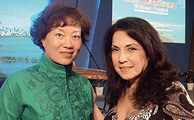
The East Coast of China is known as the ‘Gold Coast’ for a reason. Flying into Beijing, the International Airport is an overwhelming first impression as a sensational work of modern architecture. The affluence of the area is only reinforced further as the tour buses pass the designer shops of Prada, Gucci and Tiffany lining the Commercial Center.
What’s most surprising is the density of urbanization: home to tens of millions of people, the entrepreneurialism is evident everywhere as the landscape of signage from International Fortune 500 corporations is smattered with kiosks and street vendors. Capitalism would seem to be contradictory when taking into consideration their form of government, but it is foremost in the culture. Met by a Beijing native who is a CEO of a manufacturing business and his wife, I was surprised to find they were unfamiliar with the downtown center surrounding the JW Marriott where we were housed. I was informed that there are four commercial centers in Beijing as opposed to one “downtown” that services the enormous population. With approximately 24 million people, it isn’t surprising that the fast paced growth is somewhat lost on the locals with no need. Traffic is a deterring factor to a casual curiosity in learning the growth aspects of the city.
Intermixed with the cosmopolitan areas are the ancient ruins which remind the American visitor of how young the United States really is in comparison. Tour guides are very well-educated and candid to give the Chinese perspective from a culture that predates most modern societies. The pride in relaying the details of the dynasties and the eccentric stories of the ruling families was evident with each guide.
While sitting in the Renaissance Shanghai, the tallest hotel in the city, I’m reminded of the view from the John Hancock overlooking Chicago. The major difference is that in Chicago you can see O’Hare Airport past the skyline – but in Shanghai it is a spectacular show of architecture and lighting that goes as far as the eye can see; the sheer density of the new construction is shocking. In Beijing each shop has at least one person who speaks some English, usually accompanied by their English name – given to them in school. It took great pains to get someone to admit that their birth name was different and to teach me their Chinese name. In Shanghai there are not as many English-speakers in shops and English signage at historic sites is not available, which is a marked difference than what is found in the capital of Beijing. From a customer service standpoint, they expect you to buy the first item you touch and immediately go for the close –no allowance for window shopping- the sale is most important, as they realize the time tourists have is very limited.
A side trip to Suzhou and Hangzhou also was surprising in different ways. These two ‘smaller’ cities – although still in the double digit millions – are populated by the upwardly mobile and the wealthy – Hangzhou being known for having the most per capita millionaires in the country. Our group of Chamber of Commerce Executives joined a business expo banquet where I was graciously asked to join the head table by Ms. Tong Guill, the Deputy Mayor of Hangzhou. Of all the chambers represented, she later told me that Miami Beach was the most global and international. In fact, seated across from me was one of the owners of Bazaar Restaurant in Miami Beach’s SLS Hotelpurely coincidental; this demonstrated the reach that Miami Beach has had in international investors.
We were able to have some business meetings outlining the regulations for foreign companies in China, banking restrictions, approved business models, and more. For example, the generational difference between the older workforce growing up under the strict communist rule and the younger professionals who have their pick of high paying positions provides for a complicated human resources dynamic as the more conservative and less communicative professional is at the management level: this was one cause for employee turnover identified in a presentation by Beecher Ashely-Brown, an HR consultant affiliated with Aon Hewitt China. The bottom line: everything is possible in China, but nothing is easy.
I was overcome with sheer awe in the Palace Museum, also known as the Forbidden City. The Summer Palace enabled me to sense how a different culture existed with Royals and Dynasties, so unknown in our short history. I wasn’t the only one; many Chinese had traveled from inland for the same tourist experience. The rural Chinese had never seen a foreigner before and I was often asked to pose for pictures. China was not on my bucket list, but I admit it was fascinating and the prospect of doing business with their powerful economy is one that should be entertained.






